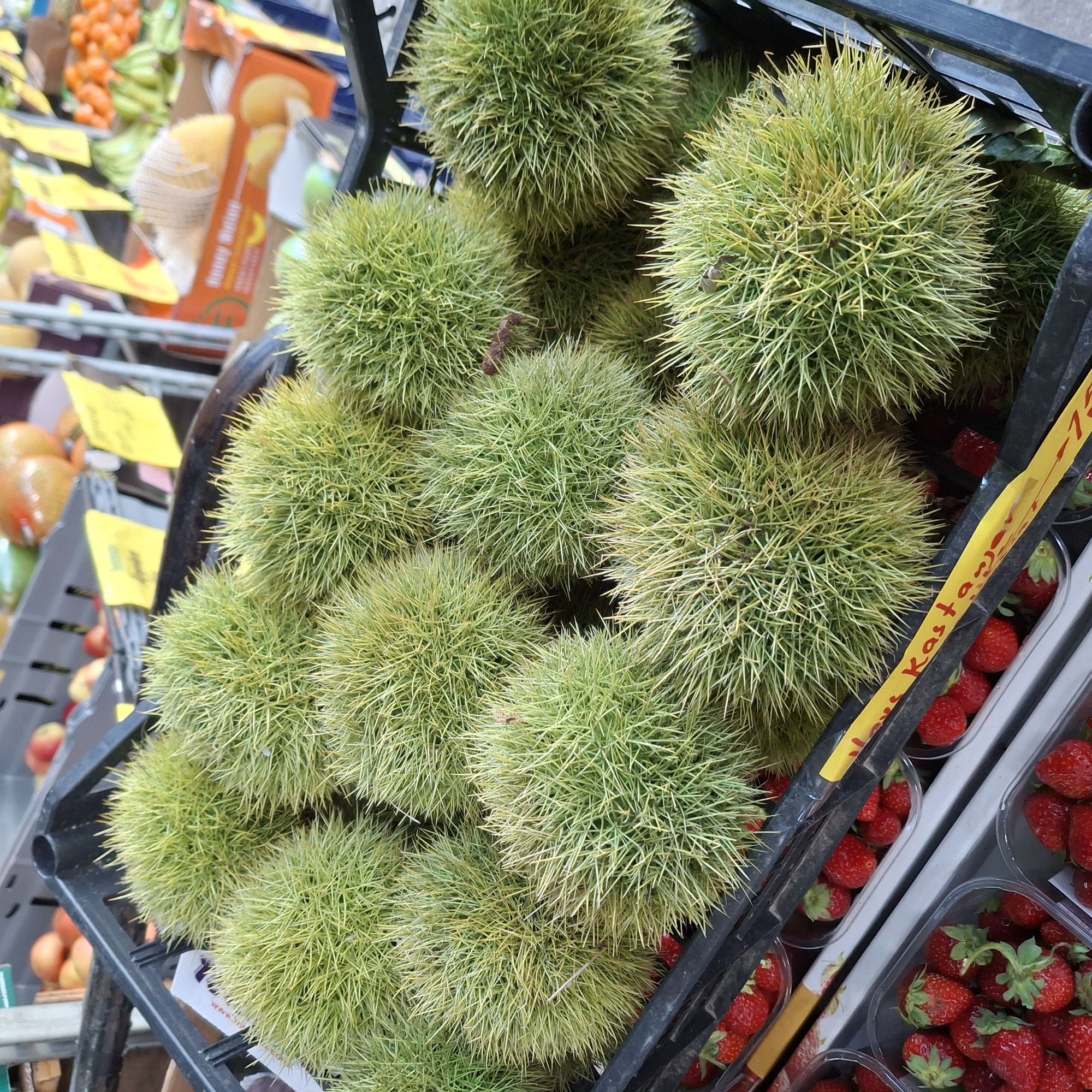When you think of Italian autumn, few symbols are as evocative as the castagna—the chestnut. Roasted in street carts under swirling leaves, they crackle and steam in brown paper cones, warming hands and hearts. Italian kids grow up dreaming of that aroma, of the first cold wind followed by the scent of roasting chestnuts in piazzas and alleyways.
The chestnut: nature’s autumn jewel
In Italian, the word castagna describes the seed of the chestnut tree. The fruit lives inside a prickly husk (the “riccio”) that splits open when mature, revealing one to three shiny nuts. The external shell is dark brown, with a lighter patch called the ilo at the base, and sometimes a “torch” (the remains of styles) at the tip.
Historically, chestnuts played a vital role in Italian peasant diets. In mountainous areas—where grain was hard to grow—they were called il cereale che cresce sull’albero (the cereal that grows on trees).
They were eaten fresh, dried, or ground into flour to make porridge, bread, cakes. Over time, special cultivars known as marroni (a kind of “premium chestnut”) were developed—nuts with less splitting, easier peeling, and sweeter flesh.
In Tuscany and other parts of Italy, a beloved traditional cake is castagnaccio—a rustic flat cake made of chestnut flour, water, olive oil, pine nuts, raisins (and sometimes rosemary)
It’s austere but deeply tied to the earth and autumn itself.
Also, in the region of Monte Amiata, the Castagna del Monte Amiata has IGP status as a regional chestnut variety, reflecting its cultural and gastronomic importance.
Autumn street dreams: roasted chestnuts
Picture a crisp November evening in an Italian town. The lamps glow, chestnut vendors wheel out carts, and the air fills with the scent of roasting shells. Children press their noses to the glass, warming their hands. Parents buy cones of caldarroste (roasted chestnuts) for walking, nibbling, sharing. It’s sensory magic.
In some places, these “chestnut festivals” (castagnate) are local traditions where communities gather, roast chestnuts in big drums, serve chestnut-based sweets and soups, and socialize under golden leaves. In parts of central-northern Italy, mid-November is often when these fall festivities are held.
Beyond street roasting, chestnuts evolved into refined desserts.
Monte Bianco (also Mont Blanc in French) is one of the most poetic. It’s a “mountain” of sweetened chestnut purée, piped into vermicelli-like strands, often over whipped cream, sometimes enriched with cocoa or rum—meant to evoke snow-capped peaks.
Marrons glacés: these are chestnuts candied in syrup, glazed, and often sold individually in decorative form. It’s a time-consuming confection—but one that changed chestnuts into luxury treats.
You’ll also find chestnut creams, chestnut ice creams (Mont Blanc–style), chestnut tarts, biscotti with chestnut flour, and more.
These recipes show how the humble chestnut can be transformed—from street snack to elegant dessert.
Our twist at Lasagnariet
As with mushrooms and lasagna, at Lasagnariet we love experimenting. This autumn, we had the chance to work with Italian chestnut flour, blended with wheat flour and cocoa, and we created a warm sweet cannellone filled with chocolate and ricotta. Rich, nutty, slightly sweet, with just enough earthiness to hint of forests and hearths.
But that’s not all. We wondered: why not put chestnuts in savory lasagna too? Imagine a smoked pork belly ragu lasagna, enhanced with chestnut purée, seasoned with thyme and red wine, and bound together by a parmigiano béchamel. The chestnuts add a subtle nutty sweetness and body, deepening the savory layers rather than stealing the show. Sound ambitious? We think it’s delicious in concept—and we’ll try it.
And for the plant-based hearts: we decided to make a vegan soup—a velvety treasure of potatoes, porcini mushrooms, and chestnuts. Creamy but light, comforting yet energized, perfect for those foggy, damp days when you need warmth in a bowl.
Here’s a sketch of how it works:
Soak dried porcini (if using) in warm water, reserve liquid.
Roast or steam chestnuts, peel them, then simmer with potatoes and broth until soft.
Blend until silky smooth, adding the porcini infusion for depth.
Adjust seasoning, maybe finish with a drizzle of olive oil, thyme, or crushed chestnut bits for crunch.
This soup is about energy and comfort, a bowl that grounds you in autumn’s slow, thoughtful pace.
Layers of culture, flavor & experimentation
From roasted caldarroste in Italian streets, to Monte Bianco mountains of chestnut cream, to candied marrons, to rustic cakes like castagnaccio—chestnuts carry both history and poetry. We want them too in our layered narrative at Lasagnariet: in sweet cannelloni, in lasagna, in soup.
We are fascinated by what nature offers—what the chestnut can teach us about richness, both sweet and savory—and how we can build new layers from old traditions.
At Lasagnariet, we don’t just serve meals. We tell stories, season to season. We try ideas. We layer surprises.

